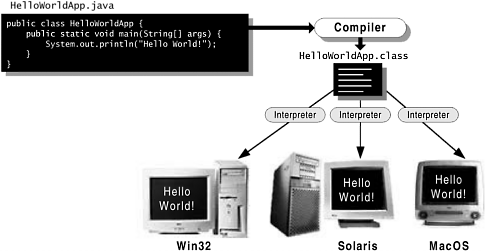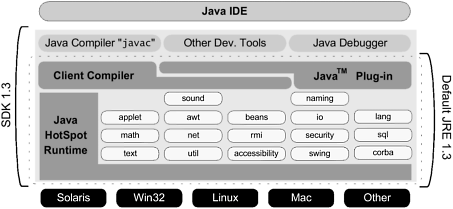About the Java Technology
Talk about Java technology seems to be everywhere, but what exactly is it? The next two sections explain how it is both a programming language and a platform.
The Java Programming Language
The Java programming language is a high-level language that can be characterized by all the following buzzwords: [1]
[1] Each of these terms is explained in "The Java Language Environment," a white paper by James Gosling and Henry McGilton. You can find this white paper at http://java.sun.com/docs/white/langenv/index.html
- Simple
- Object oriented
- Distributed
- Interpreted
- Robust
- Secure
- Architecture neutral
- Portable
- High performance
- Multithreaded
- Dynamic
With most programming languages, you either compile or interpret a program so that you can run it on your computer. The Java programming language is unusual in that a program is both compiled and interpreted. With the compiler, first you translate a program into an inter-mediate language called Java bytecodesthe platform-independent codes interpreted by the interpreter on the Java platform. The interpreter parses and runs each Java bytecode instruction on the computer. Compilation happens just once; interpretation occurs each time the program is executed. Figure 1 illustrates how this works.
Figure 1. Programs written in the Java programming language are first compiled and then interpreted.

You can think of Java bytecodes as the machine code instructions for the Java Virtual Machine (Java VM). Every Java interpreter, whether it's a development tool or a Web browser that can run applets, is an implementation of the Java VM.
Java bytecodes help make "write once, run anywhere" possible. You can compile your program into bytecodes on any platform that has a Java compiler. The bytecodes can then be run on any implementation of the Java VM. That means that as long as a computer has a Java VM, the same program written in the Java programming language can run on Windows 2000, a Solaris workstation, or on an iMac, as shown in Figure 2.
Figure 2. Programs can be written once and run on almost any platform.

The Java Platform
A platform is the hardware or software environment in which a program runs. We've already mentioned some of the most popular platforms, such as Windows 2000, Linux, Solaris, and MacOS. Most platforms can be described as a combination of the operating system and hardware. The Java platform differs from most other platforms in that it's a software-only platform that runs on top of other, hardware-based platforms.
The Java platform has two components:
- The Java Virtual Machine (Java VM)
- The Java Application Programming Interface (Java API)
You've already been introduced to the Java VM. It's the base for the Java platform and is ported onto various hardware-based platforms.
The Java API is a large collection of ready-made software components that provide many useful capabilities, such as graphical user interface (GUI) widgets. The Java API is grouped into libraries of related classes and interfaces; these libraries are known as packages. The next section highlights what functionality some of the packages in the Java API provide.
Figure 3 depicts a program that's running on the Java platform. As the figure shows, the Java API and the virtual machine insulate the program from the hardware.
Figure 3. The Java API and the Java VM insulate a program from hardware dependencies.

Native code is code that, after you compile it, runs on a specific hardware platform. As a platform-independent environment, the Java platform can be a bit slower than native code. However, smart compilers, well-tuned interpreters, and just-in-time bytecode compilers can bring performance close to that of native code without threatening portability.
What Can Java Technology Do?
The most common types of programs written in the Java programming language are applets and applications. If you've surfed the Web, you're probably already familiar with applets. An applet is a program that adheres to certain conventions that allow it to run within a Java-enabled browser. To see a running applet, go to this page in the online version of this tutorial:
There you can see an animation of the Java platform's mascot, Duke, waving at you:
![]()
However, the Java programming language is not just for writing cute, entertaining applets for the Web. The general-purpose, high-level Java programming language is also a powerful software platform. Using the generous API, you can write many types of programs.
An application is a standalone program that runs directly on the Java platform. A special kind of application known as a server serves and supports clients on a network. Examples of servers are Web servers, mail servers, and print servers.
Another specialized program is a servlet. A servlet can almost be thought of as an applet that runs on the server side. Java servlets are a popular choice for building interactive Web applications, replacing the use of CGI scripts. Servlets are similar to applets in that they are runtime extensions of applications. Instead of working in browsers, though, servlets run within Java Web servers, configuring or tailoring the server.
How does the API support all these kinds of programs? It does so with packages of software components that provide a wide range of functionality. Every full implementation of the Java platform gives you the following features:
- The essentials: Objects, strings, threads, numbers, input and output, data structures, system properties, date and time, and so on.
- Applets: The set of conventions used by Java applets.
- Networking: URLs, TCP (Transmission Control Protocol), UDP (User Datagram Protocol) sockets, and IP (Internet Protocol) addresses.
- Internationalization: Help for writing programs that can be localized for users worldwide. Programs can automatically adapt to specific locales and be displayed in the appropriate language.
- Security: Both low level and high level, including electronic signatures, public and private key management, access control, and certificates.
- Software components: Known as JavaBeans™, can plug into existing component architectures.
- Object serialization: Allows lightweight persistence and communication via RMI (Remote Method Invocation).
- Java Database Connectivity (JDBC™): Provides uniform access to a wide range of relational databases.
The Java platform also has APIs for 2D and 3D graphics, accessibility, servers, collaboration, telephony, speech, animation, and more. Figure 4 depicts what is included in the Java 2 SDK.
Figure 4. The Java 2 SDK, Standard Edition v. 1.3. The Java 2 Runtime Environment (JRE) consists of the Java VM, the Java platform core classes, and supporting files. The Java 2 SDK includes the JRE and development tools, such as compilers and debuggers.

This book covers the Java programming language and parts of the core API that beginning-to intermediate-level programmers will use most frequently. If you need additional information not found in this book, you can explore the other two books in The Java Tutorial series: The JFC Swing Tutorial and The Java Tutorial Continued. The contents of both books are included on the CD that accompanies this book and can be found in the online tutorial:
http://java.sun.com/docs/books/tutorial/index.html
Getting Started
- About the Java Technology
- How Will Java Technology Change My Life?
- First Steps (Win32)
- First Steps (UNIX/Linux)
- First Steps (MacOS)
- A Closer Look at HelloWorld
- Questions and Exercises
- Code Samples
Object-Oriented Programming Concepts
- What Is an Object?
- What Is a Message?
- What Is a Class?
- What Is Inheritance?
- What Is an Interface?
- How Do These Concepts Translate into Code?
- Summary
- Questions and Exercises
- Code Samples
Language Basics
Object Basics and Simple Data Objects
Classes and Inheritance
Interfaces and Packages
Handling Errors Using Exceptions
- What Is an Exception?
- The Catch or Specify Requirement
- Catching and Handling Exceptions
- Specifying the Exceptions Thrown by a Method
- How to Throw Exceptions
- Runtime Exceptions The Controversy
- Advantages of Exceptions
- Summary of Exceptions
- Questions and Exercises
- Code Samples
Threads: Doing Two or More Tasks at Once
- What Is a Thread?
- Using the Timer and TimerTask Classes
- Customizing a Threads run Method
- The Life Cycle of a Thread
- Understanding Thread Priority
- Synchronizing Thread
- Grouping Threads
- Summary of Threads
- Questions and Exercises
- Code Samples
I/O: Reading and Writing
- Overview of I/O Streams
- Using the Streams
- Object Serialization
- Working with Random Access Files
- And the Rest…
- Summary of Reading and Writing
- Questions and Exercises
- Code Samples
User Interfaces That Swing
- Overview of the Swing API
- Your First Swing Program
- Example Two: SwingApplication
- Example Three: CelsiusConverter
- Example Four: LunarPhases
- Example Five: VoteDialog
- Layout Management
- Threads and Swing
- Visual Index to Swing Components
- Summary
- Questions and Exercises
- Code Samples
Appendix A. Common Problems and Their Solutions
- Appendix A. Common Problems and Their Solutions
- Getting Started Problems
- General Programming Problems
- Applet Problems
- User Interface Problems
Appendix B. Internet-Ready Applets
- Appendix B. Internet-Ready Applets
- Overview of Applets
- AWT Components
- Taking Advantage of the Applet API
- Practical Consideration of Writing Applets
- Finishing an Applet
- Swing-Based Applets
- Code Samples
Appendix C. Collections
- Appendix C. Collections
- Introduction
- Interfaces
- Implementations
- Algorithms
- Custom Implementations
- Interoperability
Appendix D. Deprecated Thread Methods
- Appendix D. Deprecated Thread Methods
- Why Is Thread.stop Deprecated?
- Why Are Thread.suspend and Thread.resume Deprecated?
- What about Thread.destroy?
- Why Is Runtime.runFinalizersOnExit Deprecated?
Appendix E. Reference
EAN: 2147483647
Pages: 125
